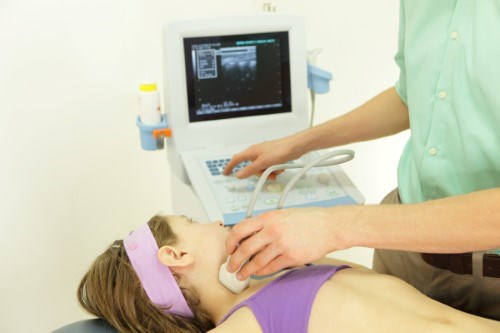A previously healthy 9-year-old female presented to the emergency department with a 10-day history of progressive left-eye bulging.
The child and her family denied eye pain, vision changes, recent falls, injury to the eye, or insect bites. Her parents also denied any recent headache, blurry vision, photophobia, fever, cough, runny nose, vomiting, chest pain, palpitations, diarrhea, constipation, or rash. Mom reported that her child had weight loss and cold sensitivity in the past couple of months. She also reported that 10 days ago, she also noticed that her child’s neck looked larger. There were no known sick contacts, including COVID-19 exposures.
The patient’s vital signs were: BP 120/76 mmHg; pulse 144 bpm; RR 24 breaths/min; temperature 36.8 C; and SpO2 97% on room air.
On physical examination, the patient was well-appearing; head normocephalic and atraumatic; left eye proptosis present, normal conjunctiva, EOM, PERRL, unremarkable fluorescein exam; neck with full range-of-motion; no palpable mass tachycardia without murmurs; lungs clear to auscultation.
Workup showed: Normal CBC, BMP; TSH low < 0.01; T3 336; Free T4 2.71.
Differential diagnoses: Graves’ disease versus thyrotoxicosis, orbital cellulitis, Cushing’s syndrome, orbital myositis, myasthenia gravis, or orbital tumors.
ED management:
- Ultrasound of soft tissue head, neck, and thyroid
- Propranolol 20 mg PO and methimazole 10 mg PO
- Pediatric ophthalmology and endocrinology consultation
- Admission for observation and further endocrinology workup
Diagnosis: Thyrotoxicosis
Hyperthyroidism is defined as excessive thyroid hormone synthesis and secretion from the thyroid gland. The most common cause is Graves’ disease, followed by toxic nodular goiter.1
Thyrotoxicosis is characterized by the clinical manifestations of excess circulating thyroid hormones, regardless of the source. In addition to Graves’ disease, thyrotoxicosis often occurs in thyroiditis, iodine-induced and drug-induced thyroid dysfunction, and factitious ingestion of excess thyroid hormones.1
Thyroid storm is an acute life-threatening condition of hyperthyroidism, characterized by high fever, dehydration, tachycardia or tachyarrhythmias, tremor, nausea and vomiting, diarrhea, restlessness, extreme agitation, or signs and symptoms of multiorgan failure, inclusive of heart failure, hepatomegaly, respiratory distress, abdominal pain, delirium or coma, and possible seizure.2
While thyroid storm is rare in the pediatric age group, the peak incidence is between 11 and 15 years of age. Females are five times more likely to have thyrotoxicosis than males. Graves’ disease is the most common cause of thyrotoxicosis in the pediatric population. Risk factors include a history of Down syndrome, Turner syndrome, stress, high iodine intake, tobacco use, and family history of autoimmune thyroid disease.4
Symptoms and Signs
Thyroid-associated ophthalmopathy is the main and most common extrathyroidal manifestation of Graves’ disease. Proptosis or exophthalmos refers to the forward displacement of the globe due to an increase in retro-ocular fibroadipose tissue and swelling of extraocular muscles. Proptosis may be symmetric but is often asymmetric.3Complications include diplopia, strabismus, periorbital edema, conjunctival hyperemia and chemosis, corneal ulceration from lagophthalmos (incomplete eyelid closure), and optic nerve compression.
Cardiovascular manifestations include palpitations, widened pulse pressure, low peripheral vascular resistance, chest pain, dyspnea, cough, orthopnea, displaced apex, and murmur. Hyperthyroidism causes an increased cardiac output due to both increased peripheral oxygen demands and increased cardiac contractility. Atrial fibrillation occurs more frequently in older patients, but mitral valve prolapse is common in both adults and children.2
Gastrointestinal symptoms include failure to thrive and weight loss, even with an increase in appetite. Weight loss occurs due to increased calorigenesis, gut motility, hyper-defecation, and malabsorption.5
Behavioral symptoms include irritability, nervousness, anxiety, emotional lability, and fatigability.4
Management
Multidisciplinary approaches involving care plan coordination between endocrinology, ophthalmology, orbital surgery, and radiology typically serve patients best.2
Beta-adrenergic blockers are recommended for all symptomatic patients before definitive treatments, especially those with tachycardia, tremor, and anxiety. Recommended dose of propranolol is 1 to 2 mg/kg/day divided into 3 to 4 doses, and atenolol 1 to 2 mg/kg once a day. Atenolol is preferred in reactive airway disease because of its cardioselective characteristic.
Definitive treatments range from antithyroid medications, to radioactive iodine, to surgery:
- Antithyroid medications are the initial treatment of choice in the pediatric age group. Methimazole 0.25 to 1 mg/kg/day daily or propylthiouracil (PTU) 5 to 10 mg/kg/day twice daily are commonly used. Methimazole is preferred in children because of its convenient once-daily dosing and its less adverse effect profile. PTU is preferred in pregnancy, especially during the first trimester, because of teratogenic effects associated with methimazole.
- Radioactive iodine therapy is an option for children with adherence difficulties, children who fail medications after 1 to 2 years, and children with a major adverse reaction to medications. Absolute contraindications include pregnancy and lactation; relative contraindications include moderate to severe Graves’ ophthalmopathy and children younger than 5 years of age.
- Surgery is second line, considered for children younger than 5 years who do not respond to or experience a major adverse reaction to oral medications. Surgery also should be considered in those with a very large goiter, severe ophthalmopathy, pregnancy, persistent hyperthyroidism despite use of oral medication and radioactive iodine, and personal preference.
- If thyroid storm is suspected, treat first with beta-blocker and propylthiouracil (preferred over methimazole), then add inorganic iodine and hydrocortisone 1 to 2 mg/kg IV every eight hours. It is important to fluid resuscitate and correct any deranged electrolytes.4
References
- De Leo S, Lee SY, Braverman LE. Hyperthyroidism. Lancet. 2016;388(10047):906-918.
- Bartalena L. Graves’ Disease: Complications. In: Feingold KR, Anawalt B, Boyce A, et al., eds. Endotext. South Dartmouth (MA): MDText.com, Inc.; 2/20/2018.
- Dickinson AJ, Perros P. Controversies in the clinical evaluation of active thyroid-associated orbitopathy: use of a detailed protocol with comparative photographs for objective assessment. Clin Endocrinol (Oxf). 2001;55(3):283-303.
- Leung AKC, Leung AAC. Evaluation and Management of Children with Thyrotoxicosis. Recent Pat Endocr Metab Immune Drug Discov. 2017;11(1):22-31.
- Crocker MK, Kaplowitz P. Treatment of paediatric hyperthyroidism but not hypothyroidism has a significant effect on weight. Clin Endocrinol (Oxf). 2010;73(6):752-759.



